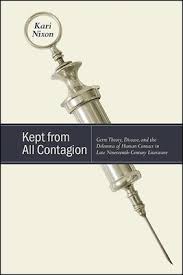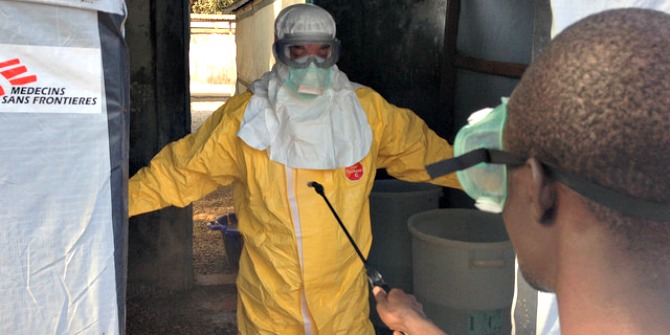In this author interview, we speak to Dr Kari Nixon about her new book Kept From All Contagion: Germ Theory, Disease and the Dilemma of Human Contact in Late Nineteenth-Century Literature. She discusses why the growing public awareness of germ theory between 1870 and 1900 makes for a fruitful period of study, how ‘Biopolitical Resistance Literature’ in the period responded to some of the anxieties that emerged, how these literary works might help us think about the challenges of the current COVID-19 pandemic and the value of the humanities for examining the implications of contagion and disease.
Q&A with Dr Kari Nixon, author of Kept From All Contagion: Germ Theory, Disease and the Dilemma of Human Contact in Late Nineteenth-Century Literature. SUNY Press. 2020.
 Q: Kept From All Contagion focuses on the period between 1870 and 1900 when germ theory had ‘gone viral’. How did germ theory mark such a dramatic change in scientific and social thinking on disease and why is this such a fruitful period of study?
Q: Kept From All Contagion focuses on the period between 1870 and 1900 when germ theory had ‘gone viral’. How did germ theory mark such a dramatic change in scientific and social thinking on disease and why is this such a fruitful period of study?
I love answering this question! Germ theory was the first moment in history when Western society became aware that most human diseases were contagious. It’s important to note that this was not the first moment humans were aware that contagion existed at all. Things like the bubonic plague were simply obviously contagious when they occurred. Diseases such as the bubonic plague and smallpox had visible dermatologic signs of illness and quick incubation periods. So, when Cousin Mary visits a shopkeeper who has buboes on his body and who dies the next day, it is pretty obvious that, three days later, when Mary develops identical buboes and dies in a similar manner, the disease is contagious. So contagion as a concept was not new. It was a new idea that most diseases were contagious, and that very particular microscopic particles caused each specific disease. What was also new with germ theory was the idea that particular people could give you a disease. The former theory was miasma theory, which held that certain unsanitary places might cause disease.
For me, this mixture of realising that most diseases are caused by specific particles harboured by people has undeniably profound effects on the way humans interacted with one another. Obviously this would make you look at your family — your own children, your spouse, your siblings, your parents — differently than you had 30 years prior. That distinctive tubercular cough that your father has always had now has implications for you, not just for him. I’m fascinated with exploring what people did with that knowledge. Did they choose community in spite of its risks? Or did they decide to opt out of interpersonal connection, because the danger was too great? To have an entire ‘slice’ of time in which everyone is grappling with this question makes it an exceptionally fruitful period of study.
Q: Your book offers a literary history of germ theory, but you look particularly at ‘Biopolitical Resistance Literature’ – including works by Charlotte Brontë, Mary Elizabeth Braddon, Thomas Hardy, Henry James and others – that challenged the social attitudes provoked by germ theory. What were some of the views and fears that these writers were contesting?
Well, the general attitude I noted in this period is the knee-jerk human reaction to avoid, avoid, avoid. None of us wants to die of plague, after all! I saw this ‘avoidant’ attitude in fiction, nonfiction, periodicals, medical products — there was a pervasive idea that if microbes were dangerous, the best thing to do was to attempt to avoid or cleanse all microbes and to create a germ-free life for humans. This seems rather natural, I think. We’ve seen it with COVID-19, too. We’ve each struggled with the question of, ‘how much bleach is enough? When have I gone too far with trying to cleanse that doorknob? How much handwashing is a problem of diminishing returns?’ Therefore, what really piqued my interest was a handful of authors I noticed not doing this. Instead of saying, ‘yes, sanitise to your heart’s content and stay away from others,’ I saw these authors depicting, say, a woman kissing a tubercular man because, in the height of their love, she doesn’t care if she gets tuberculosis from him — in the fictional space of the novel, an author can use a situation like that to say, ‘hey, maybe some relationships are worth some risk.’
 Image Credit: The peril in the air / The Peps Co. Wellcome Collection. Attribution 4.0 International (CC BY 4.0)
Image Credit: The peril in the air / The Peps Co. Wellcome Collection. Attribution 4.0 International (CC BY 4.0)
Q: Your book stresses the importance that these writers gave to ‘risk encounters’ and what we might lose in the pursuit of a mythical purity: as you put it, ‘to reject risk is to risk real connection with others’. This might feel a difficult idea to grapple with in the midst of the COVID-19 pandemic. Do these works help us navigate the dilemma we are currently facing between protective retreat and the impact of isolation on social bonds – or should we be wary of drawing too many parallels?
I was just about to make my perennial caveat about COVID-19. I do think my book has important and vast implications for life in the time of COVID, but it’s important to me that people don’t misapply my findings. Giorgio Agamben, for instance, whose work I used in my introduction to distinguish between preservation of ‘bare, biological’ life and a meaningfully enriched existence in community, has claimed that the social distancing efforts now underway constitute another form of losing our emotional and social life for the sake of our bare biological life. This was a bad take, and my argument cannot be applied this way.
The sort of aversion/avoidance I note in the 1880s was much more individualistic — akin to a ‘prepper’ mentality in which one protected themselves and had no concern for others. The sort of global social distancing we’re seeing now is immensely community-minded — we are separating so that we may again come together after we have protected as many of us as we can. In fact, far from this form of social distancing being the same type of ‘self-protective isolation’ that I note in my book, I rather think it demonstrates so beautifully what the authors of Biopolitical Resistance Literature urged: we must look out for one another, or we truly have nothing, for no person is an island. The sadness and loneliness many of us have felt in quarantine also demonstrates this sense.
A second point I’d like to make, however, now that I’ve got the chance to make it carefully and in print, is I am increasingly concerned at what I see as a quarantine-catalysed total risk aversion that does remind me of what I saw between the 1870s and 1900. I believe the global social lockdown was absolutely necessary — we were facing a great crisis of maxing out hospital capacity, and it was incredibly important that we protect as many people as we could. However, I see a lot of people saying now that they don’t want to lift restrictions until things are perfectly safe. Now, of course no one actually phrases it this way, but this is the sense I get from the broad swath of statements I’ve observed. Things will never be perfectly safe. Things never were. I don’t claim to know when or exactly how things should open up — and I’m frankly glad I’m not in charge of such decisions. But I do know that people’s perceived sense of risk seems to have been opened up by COVID-19, particularly as it has made the Western world have to face the fact that we, too, are still vulnerable to infectious disease. But with this burgeoning awareness of shared risk has come a concomitant unwillingness to encounter this risk. As my book makes clear, I don’t think that’s a viable way to live either. At some level, each of us has to think critically about what risk we’re willing to accept, how and why, and move forward. What I see around me now is a vague sense that no level of risk is acceptable, and that’s not realistic or sustainable.
Q: Your book discusses how the subject of contagion gave women authors the opportunity to explore women’s intimate relationships with other women, particularly through literary treatments of tuberculosis. How do these writers navigate the gendered implications of isolation and its particular harms for women in the period?
It is well-known that women bear the brunt of the burden of emotional labour in households. It is my absolute contention that women have struggled more than men in trying to simultaneously raise kids and keep their jobs while working at home. While women’s roles have obviously changed a lot since the 1880s, at this earlier time responsibility for the cleanliness and sanitation of the home fell to women. Working-class women were hired to actually do this cleaning, and middle- and upper-class women were seen as responsible for hiring competent employees to do this work. If illness befell a family, it was seen as due to a woman’s recklessness. Though this may function in more insidious ways today, through such concepts as emotional labour (knowing when a family is running low on bleach, making sure children wash their hands, etc), I very much believe this burden is still at play.
Q: Your book explores how fiction and drama illuminate and challenge the epidemiological understandings that emerged between 1870 and 1900 and their social consequences. What is the value of the humanities when thinking about the socio-political implications of contagion and disease?
One thing I think COVID-19 has revealed is the value of the humanities as a field of study. When the outbreak first began, I saw the typical STEM-heavy emphasis in the news; people wanted data and facts. Of course, I always try to encourage my students to realise that when dealing with disease, the data and facts we are demanding are always about people first and foremost. As the pandemic grew, and particularly as global communities faced quarantine and lockdown, I saw people more broadly recognise that data wouldn’t help us understand what we were experiencing emotionally or interpersonally. Then, I was glad to see a renewed desire for humanities-based perspectives, and for the arts generally. As much as we may want things to go back to normal, this is one of many things that I hope won’t return to normal. I hope people remember how much the arts and humanities helped them cope during this time.
Note: This interview was conducted by Dr Rosemary Deller, Managing Editor of the LSE Review of Books blog. This interview gives the views of the author, and not the position of the LSE Review of Books blog, or of the London School of Economics.
Banner Image Credit: .








The word “miasma” comes from the Ancient Greek for “stain, defilement,” and a guilty person (or later, when the church had its say, a sinner) was believed to be capable of spreading disease to anyone nearby (as long as his sins were unabsolved and the guilt/stain remained). So contagion was understood long before Pasteur got in his first labcoat.
Does this book propose a new theory to replace germ theory?